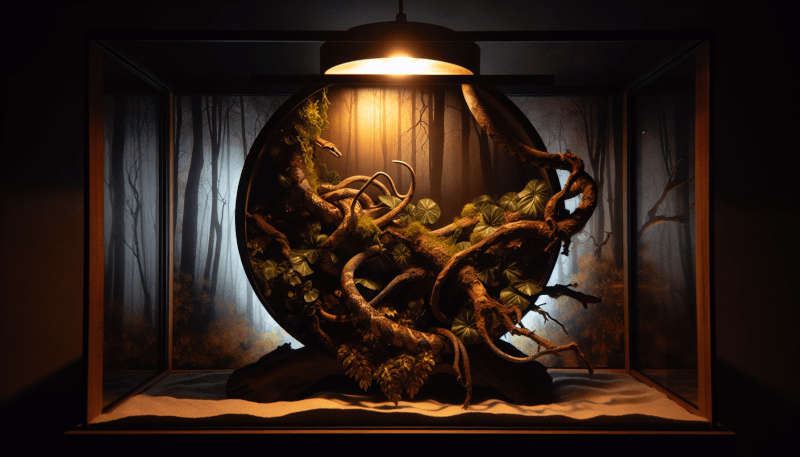Have you ever wondered how to create a safe space for your nocturnal pet snake? In this article, we will provide you with valuable insights and tips on how to ensure your snake feels comfortable and secure in its environment. From selecting the right enclosure to creating the ideal temperature and lighting conditions, you’ll discover everything you need to know to keep your nocturnal snake thriving and happy. So, grab your notebook and get ready to create a space that your scaly friend will love to call home!
Choosing the Right Enclosure
When it comes to choosing the right enclosure for your nocturnal snake, there are several factors to consider. The size and dimensions of the enclosure are crucial to ensure that your snake has enough space to move around comfortably. Snakes like to explore and climb, so it’s essential to provide them with an enclosure that is appropriately sized for their needs.
The material and design of the enclosure are also important considerations. A glass or plastic enclosure with a secure lid is often the best choice, as it allows for easy observation and provides a controlled environment. The design should promote the snake’s natural behaviors, such as climbing and burrowing, while still ensuring their safety and security.
Secure closures are essential to prevent any escapes and keep your snake safe. Snakes are excellent escape artists, and even the smallest opening or gap can be an invitation for them to explore the great unknown outside their enclosure. Make sure the closures are secure and that there are no gaps or spaces that your snake could squeeze through.
Creating the Ideal Temperature
Nocturnal snakes rely on their environment to regulate their body temperature, so it’s crucial to create the ideal temperature range within their enclosure. Understanding the optimal temperature range for your particular snake species is essential before setting up their habitat.
Providing heat sources is crucial to maintain the proper temperature for your nocturnal snake. Heat lamps, heating pads, or ceramic heaters can be used to create warm spots within the enclosure. These heat sources should be placed in a way that allows your snake to move between warmer and cooler areas as they would in their natural habitat.
Avoiding temperature extremes is vital for the well-being of your snake. While it’s important to provide warmth, extreme heat can be dangerous and lead to overheating. Similarly, exposing your snake to temperatures that are too cold can result in health issues. Monitoring the temperature within the enclosure with the help of a thermometer is a good practice to ensure that it remains within the appropriate range.
Maintaining Proper Humidity Levels
Researching the natural habitat of your nocturnal snake species is crucial to understanding the optimal humidity levels for their enclosure. Different snake species have varying requirements when it comes to humidity, so it’s important to mimic their natural habitat as closely as possible.
To maintain proper humidity levels within the enclosure, you can utilize humidifiers or misters. These can be set on timers to provide regular bursts of moisture, creating a humid environment that your snake will appreciate. It’s important, however, to ensure that the humidity does not become excessive, as this can lead to respiratory issues for your snake.
Preventing excessive dampness within the enclosure is also important. Proper ventilation is necessary to allow for air exchange and prevent the buildup of moisture. This can be achieved by ensuring there are sufficient air holes or vents in the enclosure. Regularly monitoring the humidity levels and adjusting accordingly will help maintain a suitable environment for your nocturnal snake.
Implementing Adequate Lighting
Understanding the natural behavior of nocturnal snake species is important when it comes to implementing adequate lighting in their enclosure. Nocturnal snakes are adapted to low light conditions, so it’s essential to simulate the nighttime environment as closely as possible.
Simulating moonlight within the enclosure can be beneficial for nocturnal snakes. Moonlight bulbs or low-intensity blue lights can be used to create a dim and calming atmosphere. This will provide your snake with the natural lighting conditions they are accustomed to and allow them to exhibit their normal behaviors.
Avoiding bright or constant light is crucial for the well-being of your nocturnal snake. Exposing them to bright lights for extended periods can disrupt their natural sleep-wake cycle and cause stress. It’s best to provide a dark and quiet environment during the daytime to ensure their comfort and encourage natural behaviors.

Designing the Right Substrate
Choosing the right substrate material for your nocturnal snake’s enclosure is essential for their comfort and overall well-being. The substrate serves multiple purposes, including providing a natural habitat, facilitating shedding, and maintaining proper humidity levels.
When selecting substrate material, it’s important to consider the needs of your snake species. Some snakes prefer burrowing, while others may prefer a more solid surface. Options such as aspen shavings, coconut husk, or reptile-safe soil can be suitable choices, depending on your snake’s preferences.
Providing hiding places within the substrate is important to create a secure environment for your snake. This can be achieved by adding pieces of bark, rocks, or hollow logs that will allow your snake to retreat and feel safe. These hiding places should be strategically placed throughout the enclosure to ensure that your snake has multiple options.
It’s crucial to avoid harmful substrates that can cause harm to your snake if ingested. For example, cedar shavings or newspaper ink can be toxic if ingested and should be avoided. Make sure to research the safety of different substrate materials and consult with a reptile veterinarian if you have any concerns.
Offering Suitable Hiding Spots
Understanding the natural behavior of nocturnal snakes is important when it comes to offering suitable hiding spots within their enclosure. Nocturnal snakes are known for their secretive nature and will often seek out dark and enclosed spaces to feel secure.
Incorporating natural hides within the enclosure is essential to provide your snake with the sense of security they need. These can include various objects such as caves, hollow logs, or pre-made reptile hides. It’s important to provide multiple hiding spots throughout the enclosure, allowing your snake to choose the one that suits their mood.
Creating multiple hiding areas within the enclosure is important, as it allows your snake to move between different hiding spots depending on their needs. This promotes natural behaviors and reduces stress levels. Additionally, offering hiding spots at different temperature gradients within the enclosure ensures that your snake can regulate its body temperature effectively.
Ensuring Proper Ventilation
Proper ventilation within the enclosure is crucial for maintaining a healthy and comfortable environment for your nocturnal snake. Stagnant air can lead to respiratory issues and the buildup of harmful gases, so ensuring adequate airflow is essential.
Preventing stagnant air is possible by ensuring there are sufficient air holes or vents in the enclosure. These openings allow for the exchange of fresh air and the removal of stale air. It’s important to strike a balance between ventilation and maintaining the desired humidity levels, as excessive airflow can lead to drying out of the enclosure.
Avoiding drafts is also important when it comes to ventilation. While fresh air is essential, drafts can create temperature fluctuations and stress your snake. Properly positioning the enclosure away from windows or areas with direct airflow can help prevent drafts and ensure your snake’s comfort.
Maintaining a Clean Habitat
Regular cleaning of the enclosure is essential to provide a clean and hygienic environment for your nocturnal snake. Snakes, like all animals, produce waste that can accumulate and become a breeding ground for bacteria and mold if left unattended.
Regularly cleaning the enclosure involves removing any waste, uneaten food, and shed skin. Spot-cleaning should be done weekly or as necessary, while a more thorough cleaning should be done monthly. During the monthly cleaning, remove all substrate and decorations, clean them thoroughly, and sanitize them to prevent the growth of bacteria.
Preventing mold and bacteria growth is important for your snake’s health and well-being. Proper ventilation, maintaining the appropriate humidity levels, and regularly cleaning the enclosure will help minimize the risk of mold and bacteria development. If you notice any signs of mold or bacterial growth, make sure to address it promptly to ensure a safe environment for your snake.

Providing Nutritious Feeding Practices
Researching the dietary requirements of your nocturnal snake species is crucial to ensure they receive proper nutrition. Different snake species have varying dietary needs, so it’s important to understand what they require in terms of prey size, frequency of feeding, and nutritional content.
Offering properly-sized prey is key to providing a balanced diet for your snake. The size of the prey should be appropriate for the size of your snake’s mouth, ensuring they can consume it without difficulty. Providing a variety of prey items, such as mice, rats, or chicks, will help ensure your snake receives a well-rounded diet.
Avoiding overfeeding is important to prevent obesity and other health issues in your nocturnal snake. Snakes have relatively slow metabolisms, and overfeeding can lead to weight gain and related health problems. It’s important to follow recommended feeding guidelines for your specific snake species and monitor their body condition regularly.
Minimizing Stress and Disturbance
Minimizing stress and disturbance in your nocturnal snake’s environment is crucial for their overall well-being. Nocturnal snakes are typically more active and alert at night, so providing a quiet and calm environment during the day is important.
Limiting handling is necessary to minimize stress for your snake. Snakes are solitary creatures and prefer limited interaction with humans. Handling should be kept to a minimum and done with care and respect for your snake’s comfort. If it’s necessary to handle your snake, make sure to do so during their active hours at night and provide a comfortable and secure handling experience.
Providing a quiet environment during the day is important to allow your nocturnal snake to sleep and rest undisturbed. Avoid loud noises or sudden movements near their enclosure during daylight hours. It’s also important to ensure that the enclosure is placed in a quiet area of your home away from high traffic or noisy areas.
Monitoring your snake for signs of stress is crucial to ensure their well-being. Signs of stress can include decreased appetite, unusual behavior, or changes in their appearance. If you notice any signs of stress, it’s advisable to consult with a reptile veterinarian to address the issue promptly and provide the necessary support for your snake.



